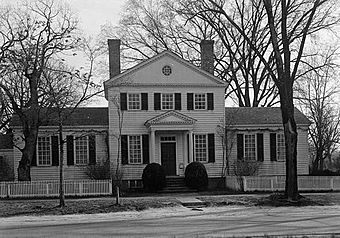James Semple House facts for kids
|
James Semple House
|
|
|
U.S. National Historic Landmark District
Contributing Property |
|

James Semple House
|
|
| Location | S side of Frances St. between Blair and Walker Sts., Williamsburg, Virginia |
|---|---|
| Area | 1 acre (0.40 ha) |
| Built | 1770 |
| Architect | Thomas Jefferson |
| Part of | Williamsburg Historic District (ID66000925) |
| NRHP reference No. | 70000864 |
Quick facts for kids Significant dates |
|
| Added to NRHP | April 15, 1970 |
| Designated NHL | April 15, 1970 |
| Designated NHLDCP | October 9, 1960 |
The James Semple House is a really old and important house in Colonial Williamsburg, Williamsburg, Virginia. It was built around 1770 and is famous for its special design. Some people think its unique look was created by Thomas Jefferson himself! This house was even named a National Historic Landmark in 1970. This means it's super important to American history.
Discovering the James Semple House
The James Semple House is found in the historic area of Colonial Williamsburg. It sits on the south side of East Francis Street. This house is a great example of early American architecture.
What Does the House Look Like?
The James Semple House is made of wood. It has a tall, two-story part in the middle. On each side of this central part, there are smaller, one-story sections. These side sections are set back a little from the main house.
The central part of the house has a pointed roof that faces the front. It looks like a triangle on top. The side sections have roofs that point to the sides. The front of the main house has three windows. The front door is in the middle. Above the door, there is a special window called a transom. A small porch with a pointed roof covers the entrance. This porch is held up by round columns.
Who Lived in the James Semple House?
We don't know the exact year the house was built. But it was probably around 1770. The Harrison family owned the land first. Benjamin Harrison V sold it to Dr. William Pasteur before 1769. It's possible a house was already there. Or maybe Dr. Pasteur built this house after he bought the land.
Some experts believe Thomas Jefferson designed the house. This is because it looks similar to other buildings he designed. The house was bought by Dr. James Semple in 1801. Later, John Tyler, who became a U.S. president, lived here. He was a relative of the Semples. He stayed here while he was going to school.
The house had a few more owners over the years. Then, in 1928, Colonial Williamsburg bought it. In 1970, when it became a National Historic Landmark, Colonial Williamsburg used it for housing for their leaders.



